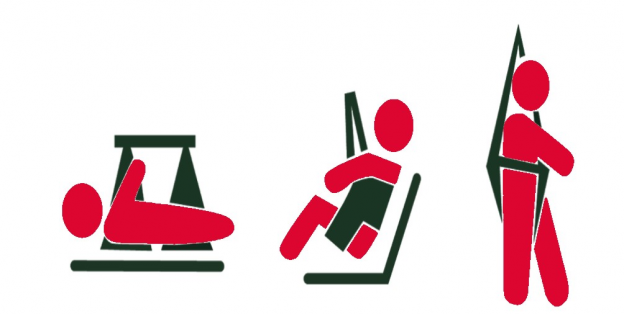Proper patient lift sling care is the most important thing a person can do to insure the longevity of a slings life. When a Sling is used to lift someone, it is vital that it is safe to use. A safety check should be done before each lift, and this should be carried out by the people who are involved in the lift. Look for any fraying or torn material or webbing. Check the stitching of the webbing on the separate loops. The Sling fabric can get caught in a washing machine at the top of the drum or under the agitator. We recommend removing any damaged Slings from use, and cutting the webbing straps off, to ensure they cannot be used again.
General Sling Washing Guidelines
- Follow the washing instructions on the sling’s product label.
- Remove plastic laths (where applicable).
- If necessary, pre-wash at low temperature.
- Machine wash at indicated temperature. Use detergent.
- Air drying is the recommended method. If Dryer is used, a delicate setting should be used. Max. temperature of 122°F. If dryer does not have a “delicate” setting, the Sling should be air dried.
- No chlorine bleaching – It can weaken the stitching and fabric.
- No dry cleaning.
- No ironing.
Check the Sling after Washing
All points are inspected with regard to wear and damage:
- Buckles (where applicable)
- Straps
- Seams
- Suspension loops
- Fabric
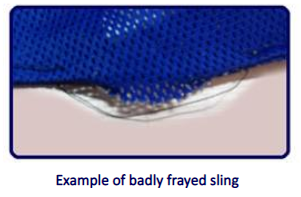
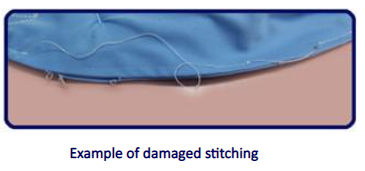
Patient Lift Sling Inspections
The sling has a limited lifetime and is an important part for safety. Do not use damaged slings. Protocol for the periodic inspections can be used as guidance as to which parts of sling care are extra important to check for with each sling model.
SMI provides inspections of not only slings, but complete patient lifts…read more about this program by clicking here.
The sling inspection procedure should be thorough, systematic and consistent; both visual and “hands on” inspection techniques are recommended. Certain forms of damage are far more discernible through hands on inspection, than by visual inspection. For example, fabric stiffness, crushed webbing, as well as thinning fabric can be identified through tactile inspection. Visual inspection alone may not reveal all forms of sling damage.
Once signs of damage have been identified, do not downgrade the work load limit of the sling with the intent of continuing to use it, but at limited capacity or frequency. This is sometimes done to get more service life out of a damaged sling. The operating rule and standard should be: intact = use; damage = do not use.
Slings should be checked before every use, and thoroughly inspected by a trained professional every 6 months to 1 year.
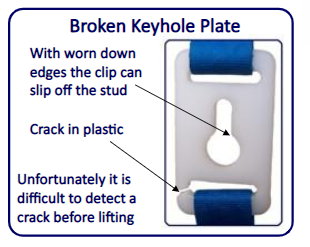
Consider removal of slings from
service if any of the following conditions exist:
- chemical or caustic burns
- melting or charring of any part of the sling
- snags, punctures, tears or cuts
- broken or worn stitches
- missing, illegible or incomplete sling tag
- knots in any part of the sling
- abrasion
- other visible damage that causes doubt as to the strength of the sling
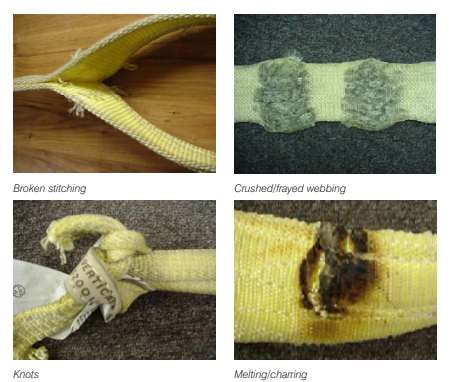
Sling Life Expectancy
The sling has a limited lifetime and is an important part for safety. Do not use damaged slings. Protocol for periodic inspection can be used as guidance as to which parts are extra important to check for each sling
model.
The longevity of a patient lift sling is determined by frequency of use and washes, washing and drying temperatures, detergent/disinfectants, patient weight, and incontinence. Average life expectancy of a sling ranges from 6 months to 3 years and is impacted by many variables.
Items of sling care which impact the integrity of slings:
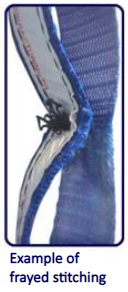
- Frequency of use
- Frequency of washes between use
- Washing temperature
- Drying temperature
- Detergents and disinfectants
- Amount of weight lifted
- Patient incontinence
- Age of sling
The life expectancy of a sling can vary from one patient sling to another. Some patients may be incontinent and soil their sling so it will need washing perhaps a few times a day. Another patient may never soil their Sling so it may not be washed for months. Washing normally damages the Sling more than lifting. Remember that bleach will greatly reduce the lifespan of a Sling.
Patient Lift Sling Care and Warranty
Manufacturer warranties that pertain to patient lifts and slings, become void if the manufacturers maintenance and inspection protocol is neglected. Damage caused by use unsuitable environmental conditions or failure to maintain the product in accordance with user and service instructions is not covered. Any alteration, modification, or repair will void the warranty. Normal wear and tear, consumer neglect and willful destruction are not cover under the manufacturers patient lift sling care and lift products.
Visit these popular pages:


